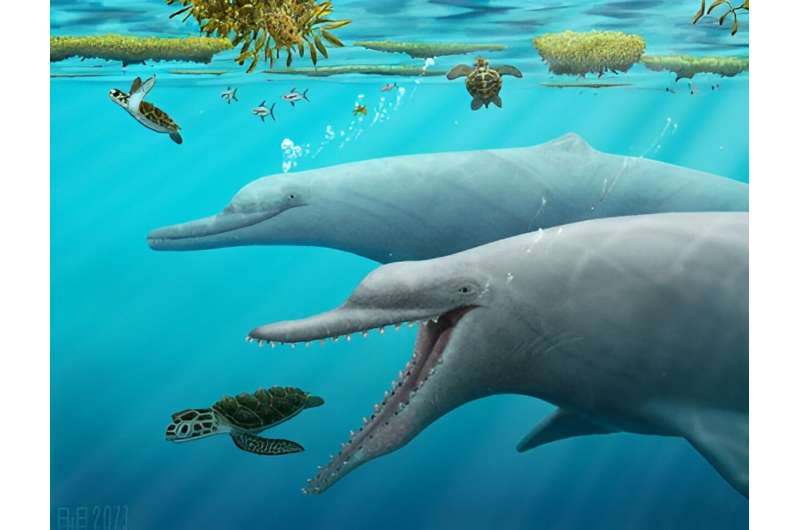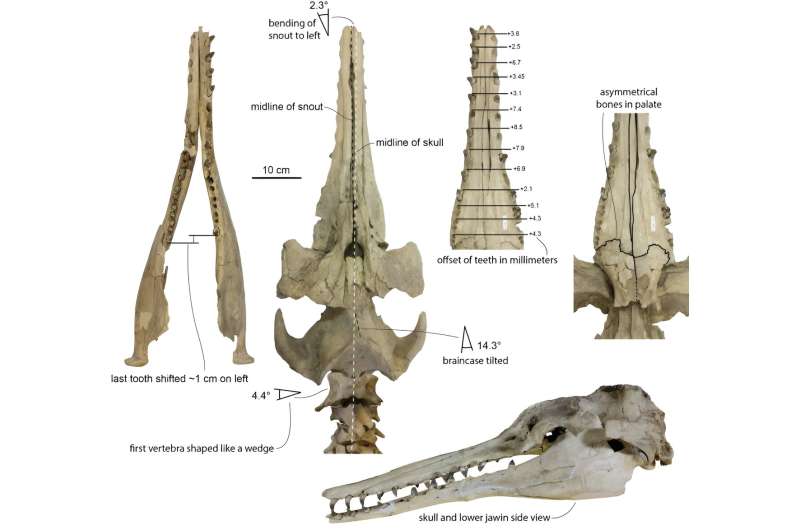This article has been reviewed according to Science X's editorial process and policies. Editors have highlighted the following attributes while ensuring the content's credibility:
fact-checked
proofread
Study reveals new clues about how whales and dolphins came to use echolocation

A study published in Diversity provides new insight into how toothed whales and dolphins came to navigate the underwater world using sound waves.
Whales and dolphins, which lack external ears, rely on a technique called echolocation to navigate and hunt in the dark. Much like shouting and listening for echoes, these animals emit high-pitched sounds that bounce off objects and reflect back at them, allowing them to map out their surroundings.
Their skulls and soft tissues near and within the blowhole are asymmetrical, meaning that a structure on one side is larger or differently shaped than its counterpart on the other side. This "lopsidedness" enables the production of sound. At the same time, a fat-filled lower jawbone conducts sound waves to the internal ear, allowing the animals to locate where sounds are coming from (directional hearing).
Yet, how whales and dolphins evolved this sophisticated "built-in sonar" is not fully understood.
Now, research co-authored by Jonathan Geisler, Ph.D., professor and chair of anatomy at New York Institute of Technology, and first author Robert Boessenecker, Ph.D., paleontologist and research associate at the University of California Museum of Paleontology, provides vital clues.

The researchers analyzed a large collection of fossils that included two ancient species of dolphins within the genus Xenorophus, one of which is new to science. These species are some of the primitive members of Odontoceti, the suborder of marine mammals that includes all living echolocating whales and dolphins.
Xenorophus was a large creature approximately three meters long that swam the waters of Eastern North America 25–30 million years ago and likely fed on fish, sharks, sea turtles, and small marine mammals. Externally, it resembled modern dolphins but had several interlocking molar-like teeth, much like an ancestral land mammal.
Similar to today's odontocetes, Xenorophus had asymmetry around the blowhole, though not as pronounced as its living relatives. Notably, it also had a distinct twisting and shifting of the snout several degrees to the left. Previous studies in other ancient whales (archaeocete whales) suggest that this "snout bend" may be linked to the asymmetrical placement of fat bodies in the jaw, increasing directional hearing abilities.
However, Xenorophus took this one step further. The fat bodies in its lower jaws, which functioned like external ears in land mammals, were tilted, further exaggerating directional hearing. This bending of the snout and tilting of the fat bodies may have been similar to the asymmetrical ears of owls, which can detect the precise location of prey based on their sounds.
The new evidence suggests that Xenorophus, with lesser pronounced asymmetry near the blowhole, may not have been as adept at producing high-pitched sounds or hearing high frequencies as living odontocetes. However, it was able to determine the location of sounds. Therefore, Xenorophus likely marked a key transition in the history of how whales and dolphins came to use echolocation.
"While this asymmetry is seen in other ancient whales, Xenorophus displays the strongest of any whale, dolphin, or porpoise, living or extinct," said Boessenecker. "In addition, although the blowhole-focused asymmetry in today's odontocetes can be traced back to Xenorophus and other relatives, the twisting and shifting of the snout is no longer seen today. This suggests that Xenorophus is a crucial puzzle piece in understanding how whales and dolphins evolved their echolocation abilities."
In addition, while many scientists focus on symmetry in nature, Geisler says their new study demonstrates the importance of also examining asymmetry.
"Biological symmetry, or the mirror-imaging of body parts across anatomical planes, is a major feature in the evolutionary history of animals and humans. However, our research shows the important role of asymmetry in adapting to different environments, and that asymmetry should be closely investigated in fossils, instead of being dismissed as individual variation or assumed to be caused by geological distortion," he says.
As a next step, the researchers will examine other odontocetes and look for the snout bent to one side. These future studies could help to determine whether the feature was widespread.
More information: Robert W. Boessenecker et al, New Skeletons of the Ancient Dolphin Xenorophus sloanii and Xenorophus simplicidens sp. nov. (Mammalia, Cetacea) from the Oligocene of South Carolina and the Ontogeny, Functional Anatomy, Asymmetry, Pathology, and Evolution of the Earliest Odontoceti, Diversity (2023). DOI: 10.3390/d15111154
Provided by New York Institute of Technology





















